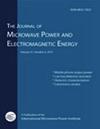Mineralogical properties of ludwigite and the effects of microwave radiation on its particle characteristics and mineral liberation properties
IF 1.5
4区 工程技术
Q4 ENGINEERING, CHEMICAL
Journal of Microwave Power and Electromagnetic Energy
Pub Date : 2022-04-03
DOI:10.1080/08327823.2022.2066770
引用次数: 1
Abstract
Abstract To effectively separate the valuable minerals in ludwigite, this study investigated the mineralogy of ore, particle-size distribution and mineral liberation characteristics. Most of the magnetite was intergrown with ascharite and serpentine. Nearly half of the serpentine existed in a dense, massive body. Most of the ascharite was encased in magnetite, and a small amount was embedded in the serpentine phase. After the microwave radiation, some intergranular and through cracks were formed to improve mineral liberation during the grinding process. The mass fractions for the +75 μm range decreased from 43.16 wt% for untreated samples to 24.31 wt% for treated samples with a microwave power of 3 kW for 40 s. By contrast, the mass fractions of particles in the −75 μm range increased from 56.84 wt% for untreated samples to 75.69 wt% for treated samples. D 50 decreased from 53.54 µm for the untreated sample to 21.58 µm for the treated sample. The liberation degrees after the treated samples clearly improved and increased by 26.64% for magnetite, 18.92% for ascharite and 14.10% for serpentine.路德辉石的矿物学性质及微波辐射对其颗粒特征和矿物解离性的影响
摘要为有效分离路德维希铁矿中有价矿物,对矿石矿物学、粒度分布及矿物解离特征进行了研究。大部分磁铁矿与菱铁矿和蛇纹石共生。近一半的蛇纹石存在于一个致密、巨大的天体中。大部分石英石包裹在磁铁矿中,少量包裹在蛇纹石相中。微波辐照后,在磨矿过程中形成了一些晶间裂纹和贯通裂纹,促进了矿物的解离。当微波功率为3 kW,微波时间为40 s时,+75 μm范围内的质量分数从未处理样品的43.16 wt%下降到处理样品的24.31 wt%。相比之下,在- 75 μm范围内的颗粒质量分数从未处理样品的56.84 wt%增加到处理样品的75.69 wt%。d50从未处理样品的53.54µm下降到处理样品的21.58µm。处理后样品的解离度明显提高,磁铁矿解离度提高26.64%,石英石解离度提高18.92%,蛇纹石解离度提高14.10%。
本文章由计算机程序翻译,如有差异,请以英文原文为准。
求助全文
约1分钟内获得全文
求助全文
来源期刊

Journal of Microwave Power and Electromagnetic Energy
ENGINEERING, CHEMICAL-ENGINEERING, ELECTRICAL & ELECTRONIC
CiteScore
2.50
自引率
6.70%
发文量
21
期刊介绍:
The Journal of the Microwave Power Energy (JMPEE) is a quarterly publication of the International Microwave Power Institute (IMPI), aimed to be one of the primary sources of the most reliable information in the arts and sciences of microwave and RF technology. JMPEE provides space to engineers and researchers for presenting papers about non-communication applications of microwave and RF, mostly industrial, scientific, medical and instrumentation. Topics include, but are not limited to: applications in materials science and nanotechnology, characterization of biological tissues, food industry applications, green chemistry, health and therapeutic applications, microwave chemistry, microwave processing of materials, soil remediation, and waste processing.
 求助内容:
求助内容: 应助结果提醒方式:
应助结果提醒方式:


